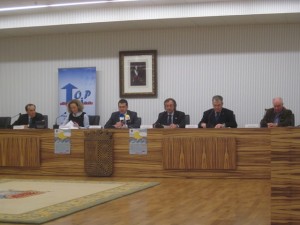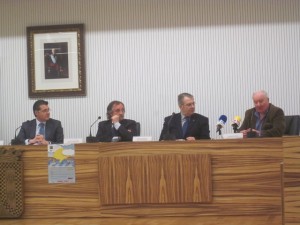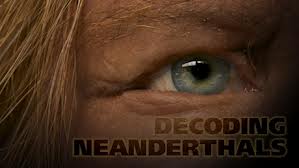Tag Archives: Neandertales
Public presentation of the course “La Sima de las Palomas and the human evolution in the SE Spain during the Pleistocene”
 Last Wednesday, March 20th, in the Torre Pacheco Council Chamber, the program of activities of the “Universidad Internacional del Mar (Universidad de Murcia)”, for the year 2013 in Torre Pacheco headquarter, was officially presented. The program has the collaboration of the Mupantquat association and the “Concejalía de Educación y Sanidad”.
Last Wednesday, March 20th, in the Torre Pacheco Council Chamber, the program of activities of the “Universidad Internacional del Mar (Universidad de Murcia)”, for the year 2013 in Torre Pacheco headquarter, was officially presented. The program has the collaboration of the Mupantquat association and the “Concejalía de Educación y Sanidad”.
The public presentation was introduced by D. Daniel García Madrid, mayor of Torre Pacheco (Murcia); D. Fernando Martín Rubio, Vice Chancellor of the University of Murcia; Dª Mª Carmen Martínez Graciá, headmaster of the “Universidad Internacional del Mar” and the directors of the courses in the program, including Dr. Michael J. Walker, from the University of Murcia.

The course will be hold from April, 27th to May,1st in the “Centro de Artes Escénicas (CAES)” in Torre Pacheco (Paseo Villa Esperanza 23, Torre Pacheco), with the following program:
Theory lessons and labs
– “Historia de un yacimiento singular: La Sima de las Palomas del Cabezo Gordo de Torre Pacheco”. Prof.: Mariano López Martínez.
– “Las Tecnologías de la Información y de la comunicación al servicio de la Paleoantropología”. Prof.: Sergio Albaladejo
– “Taller de creación de una Unidad Didáctica”. Prof.: Antonio López y Azucena Avilés.
– “Cómo se crearon el Cabezo Gordo y la Sima de las Palomas. Geología del entorno”. Prof.: Tomar Rodríguez Estrella.
– “¿Quiénes eran los neandertales?”. Prof.: María Haber Uriarte
– “Los neandertales de la Sima de las Palomas”. Prof.: Michael J. Walker
– “Avances metodológicos en la preparación y visualización de los restos humanos”. Prof.: Jon Ortega Rodrigañez
– “Evolución vegetal durante el Cuaternario en el Sureste”. Prof.: Santiago Fernández
– “El Paleolítico medio y los neandertales”. Prof.: Mariano López Martínez
– “La traceología: Análisis de huellas de uso en la Industria lítica de Sima de las Palomas”. Prof.:Ignacio Martín Lerma
– “Paleontología en rellenos karsticos. El caso de la Sima de las Palomas del Cabezo Gordo”. Prof.: Gregorio Romero
– “Exposición de Unidades didácticas”. Prof.: Antonio López
– “Cambios climáticos, cambios biogeográficos y la dispersión humana desde África y dentro de Eurasia”. Prof.: Jan Van der Made
Projections
– “Proyección documental La Cueva Negra. Audiovisual de animación y documentales científicos”
– “Proyección del documental de PBS Nova “Decoding Neandertals”.
“Decoding Neanderthals” on PBS Nova
 Last January 9th was the premeire in the U.S. of the documentary “Decoding Neanderthals” produced by PBS as part of the NOVA series. This documentaries series of popular science are produced by WGBH Boston and presented by the Public Broadcasting Service (PBS) in more than 100 countries.
Last January 9th was the premeire in the U.S. of the documentary “Decoding Neanderthals” produced by PBS as part of the NOVA series. This documentaries series of popular science are produced by WGBH Boston and presented by the Public Broadcasting Service (PBS) in more than 100 countries.
In “Decoding Neanderthals” NOVA explores the fate of Neanderthals highlighting the discoveries made at “Sima de las Palomas” site.
Program description:
Over 60,000 years ago, the first modern humans—people physically identical to us today—left their African homeland and entered Europe, then a bleak and inhospitable continent in the grip of the Ice Age. But when they arrived, they were not alone: the stocky, powerfully built Neanderthals had already been living there for hundred of thousands of years. So what happened when the first modern humans encountered the Neanderthals? Did we make love or war? That question has tantalized generations of scholars and seized the popular imagination. Then, in 2010, a team led by geneticist Svante Paabo announced stunning news. Not only had they reconstructed much of the Neanderthal genome—an extraordinary technical feat that would have seemed impossible only a decade ago—but their analysis showed that “we” modern humans had interbred with Neanderthals, leaving a small but consistent signature of Neanderthal genes behind in everyone outside Africa today. In “Decoding Neanderthals,” NOVA explores the implications of this exciting discovery. In the traditional view, Neanderthals differed from “us” in behavior and capabilities as well as anatomy. But were they really mentally inferior, as inexpressive and clumsy as the cartoon caveman they inspired? NOVA explores a range of intriguing new evidence for Neanderthal self-expression and language, all pointing to the fact that we may have seriously underestimated our mysterious, long-vanished human cousins.
(Source: PBS NOVA)




